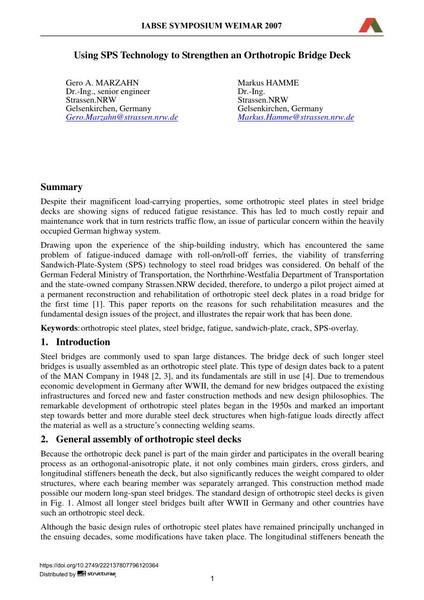Using SPS technology to strengthen an orthotropic bridge deck

|
|
|||||||||||
Bibliographic Details
| Author(s): |
Gero A. Marzahn
Markus Hamme |
||||
|---|---|---|---|---|---|
| Medium: | conference paper | ||||
| Language(s): | English | ||||
| Conference: | IABSE Symposium: Improving Infrastructure Worldwide, Weimar, Germany, 19-21 September 2007 | ||||
| Published in: | IABSE Symposium Weimar 2007 | ||||
|
|||||
| Page(s): | 220-221 | ||||
| Total no. of pages: | 8 | ||||
| Year: | 2007 | ||||
| DOI: | 10.2749/222137807796120364 | ||||
| Abstract: |
Despite their magnificent load-carrying properties, some orthotropic steel plates in steel bridge decks are showing signs of reduced fatigue resistance. This has led to much costly repair and maintenance work that in turn restricts traffic flow, an issue of particular concern within the heavily occupied German highway system. Drawing upon the experience of the ship-building industry, which has encountered the same problem of fatigue-induced damage with roll-on/roll-off ferries, the viability of transferring Sandwich-Plate-System (SPS) technology to steel road bridges was considered. On behalf of the German Federal Ministry of Transportation, the Northrhine-Westfalia Department of Transportation and the state-owned company Strassen.NRW decided, therefore, to undergo a pilot project aimed at a permanent reconstruction and rehabilitation of orthotropic steel deck plates in a road bridge for the first time [1]. This paper reports on the reasons for such rehabilitation measures and the fundamental design issues of the project, and illustrates the repair work that has been done. |
||||
| Keywords: |
fatigue crack steel bridge orthotropic steel plates sandwich-plate SPS overlay
|
||||
